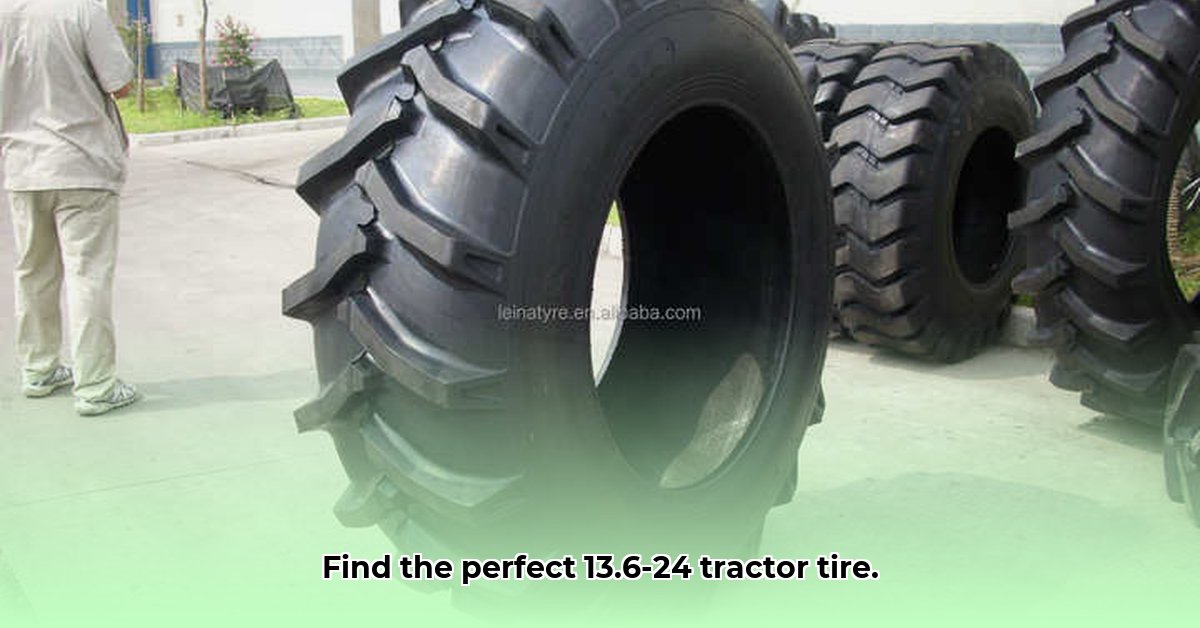
Choosing the right tractor tires is a crucial decision impacting fuel efficiency, soil health, and your farm's bottom line. This guide focuses on 13.6-24 tractor tires, providing actionable steps for selecting sustainable and high-performing options. For more information on Kubota tractor tires, check out this helpful resource: Kubota Tire Guide.
Understanding 13.6-24 Tractor Tires
13.6-24 tractor tires are available in two primary constructions: radial and bias-ply. Radial tires (think high-performance sneakers) generally offer superior fuel efficiency, a smoother ride, and longer lifespan due to their more flexible sidewalls. Bias-ply tires (like sturdy work boots) are typically more affordable but may result in increased soil compaction and shorter lifespan.
Beyond construction, understanding tire specifications is paramount. The load index indicates the maximum weight the tire can safely carry, while the speed rating defines its maximum operational speed. Matching these specifications to your tractor's capabilities and typical workload is essential to prevent tire failure. Ignoring these could lead to costly repairs and downtime.
Key Performance Indicators for Sustainable Agriculture
Several key performance indicators (KPIs) influence your tire choice. Tread depth is paramount, ensuring optimal grip, particularly in wet or muddy conditions. Deeper treads typically translate to longer tire life. Puncture resistance, crucial for minimizing downtime, should also be considered. Fuel efficiency is a significant factor. Lower rolling resistance translates directly to fuel savings over the tire's lifespan. However, simplistic rating systems like "easy test score®" often lack the necessary detail needed for comprehensive comparisons. Independent testing and detailed technical data are crucial for informed decision-making. Shouldn't we demand more thorough, transparent data from tire manufacturers?
Comparing 13.6-24 Tractor Tires: A Data-Driven Approach
Numerous 13.6-24 tractor tires are available, each with varying price points and performance characteristics. Relying solely on marketing claims is short-sighted. Instead, a data-driven approach is essential. Carefully analyze detailed specifications from independent sources, focusing on tread depth, puncture resistance, fuel efficiency, and predicted lifespan.
Comparative Table (Illustrative; actual data varies):
| Tire Brand | Price Range ($) | Tread Depth (mm) | Puncture Resistance (Rating) | Fuel Efficiency (Rating) | Estimated Lifespan (Years) | Key Features |
|---|---|---|---|---|---|---|
| Brand A | 200-250 | 25 | High | Excellent | 5-7 | Premium, high-performance, good soil compaction |
| Brand B | 150-200 | 20 | Medium | Good | 3-5 | Good value, average performance |
| Brand C | 100-150 | 15 | Low | Fair | 2-3 | Budget-friendly, may compromise on performance |
Note: Ratings are illustrative. Actual performance depends on usage and maintenance.
Selecting the Right Tire: A Step-by-Step Guide
Selecting the optimal tire involves a systematic approach. Follow these steps to make an informed choice:
- Analyze Soil Conditions: Clay soils may require aggressive tread patterns for optimal traction, whereas sandy soils might necessitate less aggressive treads.
- Assess Workload: Heavy-duty operations demand tires with high load indices to support the weight.
- Define Budget: Balance initial cost with long-term performance and fuel savings. A more expensive, durable tire might offer superior long-term value.
- Research Thoroughly: Research tires beyond simple marketing materials. Look for independent reviews and detailed technical specifications. Consider a brand’s sustainability practices.
- Prioritize Sustainability: Choose a tire that minimizes its environmental impact throughout its lifecycle – from manufacturing to disposal.
Tire Maintenance: Maximizing Lifespan and Sustainability
Proper tire maintenance is vital for extending lifespan and reducing environmental impact. Regularly check tire pressure; underinflation increases fuel consumption and uneven wear, while overinflation can cause increased risk of puncture. Regularly inspect tires for cuts, embedded objects, and unusual wear, and rotate tires periodically for even wear distribution. Choose responsible disposal methods at end-of-life.
Conclusion: Sustainable Farming Through Informed Tire Selection
Informed tire selection is crucial for sustainable and efficient farming. By understanding tire construction, key performance indicators, and performing thorough research, you can make an informed decision that positively impacts your farm's profitability and environmental footprint. Advocating for more transparent data and independent testing will help drive improvements in tire technology and sustainability standards.